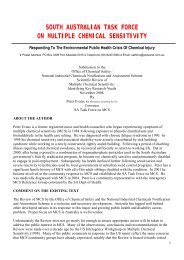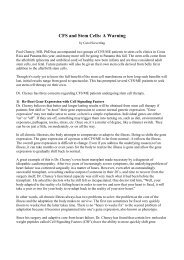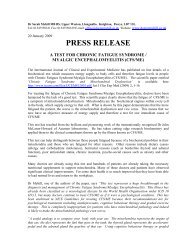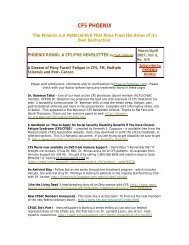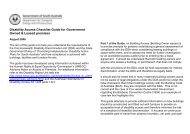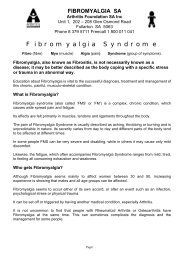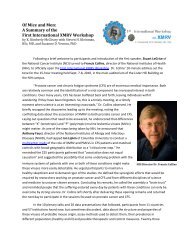6 M. Cazzola et al.enough to meet FM criteria probably have thesame underlying pathophysiology;• another unintended consequence of diagnosingFM on the basis of chronic widespread pain andat least 11 TPs is that many people with FM experiencehigh levels of distress. Wolfe has describedTPs as a “sedimentation rate for distress”because population-based studies have shownthat TPs are more common in distressed individuals(17). Distress is considered a combinationof somatic and anxiety and/or depressionsymptoms, and it has been assumed that, as TPsare associated with distress, the same is true oftenderness (i.e., sensitivity to mechanical pressure).However, recent evidence suggests that theassociation is probably due to the standard TPtechnique of applying steadily increasing pressureuntil reaching 4 kg and, in this situation,people who are anxious or “expectant” have atendency to “bail out” and report tenderness;• TP examinations require skill and, when performedincorrectly (in the wrong place or withtoo much or too little digital pressure), they leadto erroneous results. Unfortunately, the TPs ofFM are also sometimes confused with the triggerpoints of myofascial pain syndrome (MPS), andthe two are not uncommonly mistaken for eachother.To complicate the clinical picture further, FM patientsoften have symptoms that overlap with thoseof other systemic syndromes (<strong>CFS</strong>, psychogenicsyndrome, etc) or localised syndromes (MPS, irritablebowel syndrome, etc.), and many rheumatologistsdoubt that the current 1990 ACR criteria definea specific disease.Setting aside the philosophical issue raised byHazemeijer and Rasker concerning the need for aspecific change in the social setting, or “therapeuticdominion”, it has always been clear that patientsdiagnosed as having FM on the basis of the1990 ACR criteria fall into a series of heterogeneoussubgroups.Fukuda, et al., studied Air Force veterans from thefirst Gulf War in 1990-1991, and defined the complexof symptoms as “chronic multisymptom illness“(21). In 1996, Turk, et al. (22), first demonstratedthe existence of “subsets” of FM patientsthat could be identified using the MultidimensionalPain Inventory (MPI) and that would respond todifferent therapies. In addition to psychosocial andcognitive factors, they identified a number of specificneurobiological factors that could better explainthe fundamental mechanism of the pain causinghyperalgesia and allodynia.In 2003, Giesecke, et al. (23), more precisely separatedFM patients on the basis of differences intheir perception of pain and other psychologicalfactors. They studied 117 FM patients aged 18-60years (88% women) by evaluating the characteristicsand perception of pain (VAS, individual painthresholds, the number of tender points), and theway in which it was interpreted emotionally (anxiety,depression and catastrophising) (see Figure2). They quantitatively analysed six parameters foreach patient (anxiety, depression, catastrophising,ability to control pain, pain scale, and tendernessto a light touch) and identified three different clusters.The most frequent (51.5%) was cluster 1 (longdashed line), in which all levels of all parametersCLINICAL SUBSETSIn 2003, first Hazemeijer and Rasker (18), and thenEhrlich (19), raised considerable doubts about thevery existence of FM. In particular, Ehrlich consideredit only a mental construct: “When one hastuberculosis, one has tuberculosis, whether or notit is diagnosed. The same is true for cancer,rheumatoid arthritis, hookworm infestation - really,of the gamut of diseases. But not for FM. Noonehas FM until it is diagnosed.“However, given the indisputable existence of peopleaffected by a central painful syndrome, the positivistposition of Wolfe has a point: “fibromyalgiawill always exist regardless of the name given tothe syndrome” (20).Rescalated values7.06.05.04.03.02.<strong>01</strong>.00.0AnxietyDepressionCaatastrphizingControl overpainDolorimeterFigure 2 - Subgrouping of fibromyalgia patients on the basis of pressure-painthresholds and psychological factors (23).MRS
Fibromyalgia syndrome: definition and diagnostic aspects 7were medium. This probably represents the majorityof patients who consult a general practitioner(GP) because of widespread pain and who generallyrespond better to prescribed medical therapy.Cluster 2 (continuous line) represents 32% of theenrolled patients, a group that was characterised byhigh levels of anxiety, depression and catastrophising,the lowest level of control over pain,and significant tenderness to light touch.Cluster 3 (dotted line) accounted for only 16.5% ofthe patients, a group that showed the lowest levelsof anxiety, depression and catastrophising, but alsothe lowest pain threshold (see Figure 3).This study showed that patients diagnosed on thebasis of the 1990 ACR criteria fall into differentcategories and may have different reactions to theavailable therapeutic options.However, it also strongly suggested that, althoughthey had represented an unquestioned diagnosticplatform for more than ten years, the 1990 ACRcriteria alone were not sufficient to define FM patientsand, therefore, necessitated further research.At the beginning of 2006, the ACR criteria wereused by Katz, et al. (24) to verify their concordancewith the clinical diagnosis alone and with the “surveycriteria.” To this end, they studied 206 patientsevaluated on the basis of TPs using the pooled diagnosisof FM (Regional Pain Scale score >8 andfatigue score >6) and clinical history, and foundthat 49% met the criteria for a clinical diagnosis,29.1% met the 1990 ACR criteria, and 40.3% metthe survey criteria. The clinical and survey criteriawere concordant in 74.8% of cases; the clinical and1990 ACR criteria were concordant in 75.2% ofGroup 1 (n = 50)• Low tenderness• Moderate depression/anxiety• Moderate catastrophizing• Moderate control over painGroup 3 (n = 16)• High tenderness• High depression/anxiety• High catastrophizing• High control over painGroup 2 (n = 31)• High tenderness• High depression/anxiety• High catastrophizing• Low control over painFigure 3 - Subgrouping of fibromyalgia patients on the basis of pressure-painthresholds and psychological factors (23).cases; and the survey and 1990 ACR criteria wereconcordant in 72.3% of cases. Tenderness to lighttouch of at least 11 of the 18 ACR TPs was not presentin the clinical and survey diagnostic criteria butwas shown to be very useful in the clinical diagnosis.Therefore, the authors concluded that thethree sets of criteria (clinical, ACR and survey)were moderately concordant (72-75%).As there is no diagnostic “gold standard” for FM,all of the mentioned criteria are equally useful, andthe survey criteria have the undoubted advantage ofnot requiring a physical examination.DIAGNOSISIt is clear that a diagnosis of FM cannot be basedexclusively on the 1990 ACR criteria. Many subjectsmay not have pain throughout the body or atleast 11 TPs upon physical examination, but theirpsychological characteristics and associated symptomsclearly suggest a form of FM or, at any rate,a central sensitisation syndrome of which FM isclearly a part. As there are no specific laboratorymarkers, imaging techniques or objective signs,constitutional symptoms are the only parametersthat can be used.Characteristics of painIn clinical practice, FM should be suspected in allpatients describing multifocal pain that has an originwhich is not justified by the presence of tissuedamage or inflammation at the painful sites. Inmany cases, the main clinical manifestation is musculoskeletalpain; but it may be much more generalisedbecause it is known that mechanisms of sensoryamplification underlie pain of central origin.This explains why chronic headache, atypical chestpain, and chronic abdominal or pelvic pain are verycommon findings in FM patients; FM should besuspected in all patients who complain of chronicpain sine materia at these sites. As pain is the fundamentalelement of FM, it is necessary to investigateits characteristics and to differentiate it frompain induced by other diseases. Fibromyalgia painis typically diffuse or multifocal, varies in intensityduring the course of the day, and sometimes migratesfrom one body region to another; its exacerbationsare influenced by various external physicaland/or psychological factors. These are thecharacteristics of central pain, which differ fromthe more constant localization and intensity of peripheralpain. Patients sometimes perceive stimuli
- Page 2 and 3: 2 P. Sarzi-Puttini et al.The meetin
- Page 4 and 5: 4 M. Cazzola et al.(2). In the earl
- Page 8 and 9: 8 M. Cazzola et al.Table I - Charac
- Page 10 and 11: 10 M. Cazzola et al.Table IV - Cond
- Page 12 and 13: 12 M. Cazzola et al.teria, three su
- Page 14 and 15: 14 M. Cazzola et al.tients with a n
- Page 16 and 17: 16 G. Cassisi et al.The cardinal fe
- Page 18 and 19: 18 G. Cassisi et al.StiffnessIn FM
- Page 20 and 21: 20 G. Cassisi et al.Autonomic and n
- Page 22 and 23: 22 G. Cassisi et al.Associated symp
- Page 24 and 25: 24 G. Cassisi et al.46. Coleman RM,
- Page 26 and 27: 26 S. Stisi et al.sensitization,”
- Page 28 and 29: 28 S. Stisi et al.Sum oflife-events
- Page 30 and 31: 30 S. Stisi et al.trols, they prese
- Page 32 and 33: 32 S. Stisi et al.stress, obtained,
- Page 34 and 35: 34 S. Stisi et al.50. Harris RE, Cl
- Page 36 and 37: ORIGINAL ARTICLEReumatismo, 2008; 6
- Page 38 and 39: 38 F. Atzeni et al.lalanine (17), a
- Page 40 and 41: 40 F. Atzeni et al.clearer and it m
- Page 42 and 43: 42 F. Atzeni et al.healthy control
- Page 44 and 45: 44 F. Atzeni et al.and/or verbal (e
- Page 46 and 47: 46 F. Atzeni et al.for study purpos
- Page 48 and 49: 48 F. Atzeni et al.mimics of fibrom
- Page 50 and 51: ORIGINAL ARTICLEReumatismo, 2008; 6
- Page 52 and 53: 52 P. Sarzi-Puttini et al.A larger
- Page 54 and 55: 54 P. Sarzi-Puttini et al.from 1966
- Page 56 and 57:
56 P. Sarzi-Puttini et al.rational,
- Page 58 and 59:
58 P. Sarzi-Puttini et al.49. Toffe
- Page 60 and 61:
60 R. Casale et al.cal exercise and
- Page 62 and 63:
62 R. Casale et al.definition of
- Page 64 and 65:
64 R. Casale et al.are more or less
- Page 66 and 67:
66 R. Casale et al.trol associated
- Page 68 and 69:
68 R. Casale et al.32. Lewit K. The
- Page 70 and 71:
ORIGINAL ARTICLEReumatismo, 2008; 6
- Page 72 and 73:
72 L. Altomonte et al.In a clinical
- Page 74 and 75:
74 L. Altomonte et al.Table II - We
- Page 76 and 77:
76 L. Altomonte et al.treatments de



